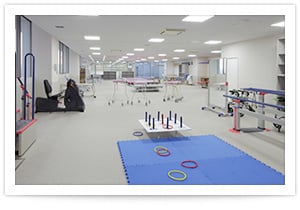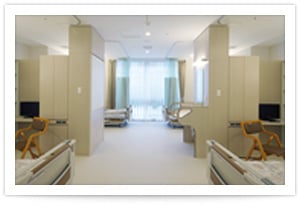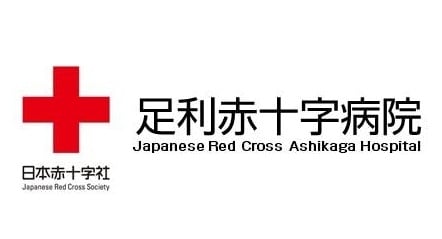Rehabilitation Department
Rehabilitation Department 2017 Staff
| |
Doctors
| 2
|
Dentists
| 3
|
Physical Therapists
| 31
|
Occupational Therapists
| 16
|
Speech Therapists
| 12
|
Dental Hygienists
| 2
|
Rehabilitation medicine is the science of “activity.” Rehabilitation is treatment that enables patients to expand their sphere of activity.
Activity and Rehabilitation

“Activity” is the fundamental movement and action that humans undertake in order to live their lives. It can be divided into three broad categories: movement, process and communication. We share these functions with animals as well.
We make many demands in order to lead our lives. If we decided that we want to eat something, we may head to a restaurant (movement), order some food (communication), and then consume it (process). This is one simple example, but our lives are basically a repetition of these three main activities. However, illness or injury may prevent us from being able to carry out one or more of these activities. For example, if one were to break a leg, the movement to a restaurant could become difficult or impossible. However, in most cases, broken bones can be treated, and a full range of activity restored.
As another example, consider the case of a stroke. The brain is composed of nerve cells, and cannot heal the way bones do. If there is paralysis in a hand or leg, it may never hear completely. And that would prevent recovery of a full range of activity.
However, we possess a special skill known as “motor learning” which gives us the ability to acquire new physical skills. For example, with practice, we can learn to ride a bicycle, or play a musical instrument. Through exercise or training programs, these skills can be perfected to the point where such tools or instruments become virtually a part of our own bodies. This is the kind of work that we are doing.
If one has paralysis, that means that the structure of function of the body has changed. By implementing a training program appropriate for these changes, activity can once again become possible, just as one becomes more skilled with a musical instrument the more one practices. While in many cases the actual paralysis may not be improved, by utilizing remaining functions as much as possible, using appropriate tools, and training effectively many things can become possible again. The treatment that makes this possible is what we call rehabilitation. By “tools” we mean prosthetics, supports, canes and the like. When the tools are tailored to the individual needs of each patient, their sphere of possible activity can be greatly improved.
Our role in this department is to plan and execute appropriate motor training to help patients to go about their daily lives as independently as possible without risk or strain.
We make many demands in order to lead our lives. If we decided that we want to eat something, we may head to a restaurant (movement), order some food (communication), and then consume it (process). This is one simple example, but our lives are basically a repetition of these three main activities. However, illness or injury may prevent us from being able to carry out one or more of these activities. For example, if one were to break a leg, the movement to a restaurant could become difficult or impossible. However, in most cases, broken bones can be treated, and a full range of activity restored.
As another example, consider the case of a stroke. The brain is composed of nerve cells, and cannot heal the way bones do. If there is paralysis in a hand or leg, it may never hear completely. And that would prevent recovery of a full range of activity.
However, we possess a special skill known as “motor learning” which gives us the ability to acquire new physical skills. For example, with practice, we can learn to ride a bicycle, or play a musical instrument. Through exercise or training programs, these skills can be perfected to the point where such tools or instruments become virtually a part of our own bodies. This is the kind of work that we are doing.
If one has paralysis, that means that the structure of function of the body has changed. By implementing a training program appropriate for these changes, activity can once again become possible, just as one becomes more skilled with a musical instrument the more one practices. While in many cases the actual paralysis may not be improved, by utilizing remaining functions as much as possible, using appropriate tools, and training effectively many things can become possible again. The treatment that makes this possible is what we call rehabilitation. By “tools” we mean prosthetics, supports, canes and the like. When the tools are tailored to the individual needs of each patient, their sphere of possible activity can be greatly improved.
Our role in this department is to plan and execute appropriate motor training to help patients to go about their daily lives as independently as possible without risk or strain.
Physical, Occupational and Speech Therapy

Within the discipline of rehabilitation, there are three specialties: physical therapist (PT), occupational therapist (OT), and speech therapist (ST). Each of these corresponds to one of the three major aspects of “activity,” with PTs for movement, OTs for process, and STs for communication. Working with patients, these specialists help build up existing motor function, as well as to train new ones in order to expand the range of possible activity. In addition to these main themes, eating/swallowing and excretion and also important areas for work. Eating/swallowing is obviously crucial as the method by which nutrition is brought into the body in order to sustain life. Swallowing, a process virtually invisible to the observer, is nonetheless crucial (particularly given the need to avoid choking), and specialist staff work on this with patients as well. Since it’s related to the mouth and throat, speech and hearing therapy techniques have a large role to play. In addition, at our hospital, dentists and dental hygienists also participate in the rehabilitation process.
Excretory activities should ideally take place at appropriate times and places. While waste products are produced without any conscious effort, “appropriate” excretion itself requires some degree of conscious control. Without this, incontinence, or the opposite, can become a major concern. For this, medication, catheters and other techniques can be used in the rehabilitation process. As an important part of daily life, OTs primarily work with patients but nurses also have a role to play.
As you can see, our rehabilitation program is very much a “team” or interdisciplinary effort, with numerous specialists working to make sure each patient gets precisely what their condition requires.
Excretory activities should ideally take place at appropriate times and places. While waste products are produced without any conscious effort, “appropriate” excretion itself requires some degree of conscious control. Without this, incontinence, or the opposite, can become a major concern. For this, medication, catheters and other techniques can be used in the rehabilitation process. As an important part of daily life, OTs primarily work with patients but nurses also have a role to play.
As you can see, our rehabilitation program is very much a “team” or interdisciplinary effort, with numerous specialists working to make sure each patient gets precisely what their condition requires.
The Rehabilitation Ward

Built in 2011, our 50-bed Rehabilitation Ward is one of the largest in Japan, with the therapy center located adjacent to the ward, and 90m walking area and other state-of-the-art equipment making for efficient therapy and recovery.
The concept of a Rehabilitation Ward is as a treatment center for patients who are no longer in the critical phase of care related to their illness or injury, and are instead focusing on recovering their physical functions. The Japanese Ministry of Health, Labor and Welfare has approved this concept.
The ward is designed for treating patients who are recovering from the effects of nerve damage due to a stroke, major surgery, severe injuries, joint problems, or general physical weakness due to long periods being bed-ridden (disuse syndrome), and who have difficulty carrying out daily tasks, but with therapy can be expected to be able to once again live successfully in their homes.
The regulations of the program require that patients be admitted within 2 months (or 1 month, depending on their specific illness) from the time their symptoms first develop. Admissions after this time are not permitted, and there is also a limit to how long patients can be admitted (from 60 to 180 days, depending on their specific condition). During this period, of course we work intensely with the patient in the hope they can ultimately be discharged back to their home.
In cases where full recovery is not deemed possible, we work with specialists and consider many options as we try to decide whether a patient can function safely at home.
In order to achieve these goals, we’ve put together a great multidisciplinary team of specialists, including rehabilitation doctors, dentists, physical therapists, occupational therapists, speech therapists, nurses, dental hygienists, medical social workers and certified care workers. From the critical phase through the recovery stage, we provide a consistent program of rehabilitative therapy and care aiming to remove obstacles to our patients’ activity, and a fulfilling daily life.
The concept of a Rehabilitation Ward is as a treatment center for patients who are no longer in the critical phase of care related to their illness or injury, and are instead focusing on recovering their physical functions. The Japanese Ministry of Health, Labor and Welfare has approved this concept.
The ward is designed for treating patients who are recovering from the effects of nerve damage due to a stroke, major surgery, severe injuries, joint problems, or general physical weakness due to long periods being bed-ridden (disuse syndrome), and who have difficulty carrying out daily tasks, but with therapy can be expected to be able to once again live successfully in their homes.
The regulations of the program require that patients be admitted within 2 months (or 1 month, depending on their specific illness) from the time their symptoms first develop. Admissions after this time are not permitted, and there is also a limit to how long patients can be admitted (from 60 to 180 days, depending on their specific condition). During this period, of course we work intensely with the patient in the hope they can ultimately be discharged back to their home.
In cases where full recovery is not deemed possible, we work with specialists and consider many options as we try to decide whether a patient can function safely at home.
In order to achieve these goals, we’ve put together a great multidisciplinary team of specialists, including rehabilitation doctors, dentists, physical therapists, occupational therapists, speech therapists, nurses, dental hygienists, medical social workers and certified care workers. From the critical phase through the recovery stage, we provide a consistent program of rehabilitative therapy and care aiming to remove obstacles to our patients’ activity, and a fulfilling daily life.
